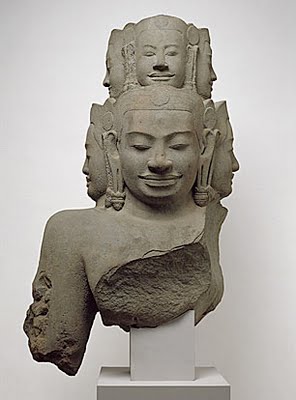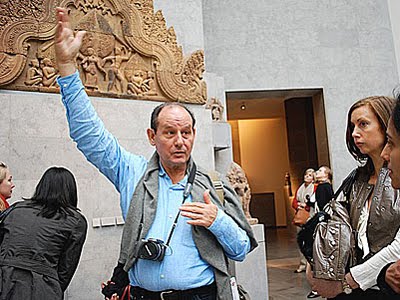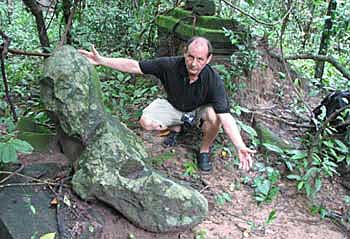Hevajra on display
Peter Sharrock is a former Vietnam War correspondent turned archaeology professor, and is now a senior teaching fellow in the art and archeology of Southeast Asia at the University of London's School of Oriental and African Studies. He covered Indochina for four years as a reporter and finally made it to Angkor in 1990. His doctorate is on a new interpretation of the Buddhism and imperial politics of King Jayavarman 7th. He is now focusing on the evidence in Indochina for the influence of tantric or esoteric Buddhism, developed in the Ganges valley and developed in different ways throughout Asia. His interest in Hevajra, a warlike tantric deity, prompted him to go looking for the missing parts of the 3-metre high sandstone statue that he'd seen in yellowing photographs from EFEO. The bust is now with the Metropolitan Museum of Art in New York but the rest of the body - all 16 arms, one of its heads and its legs - lie elsewhere. The discovery of the legs of Hevajra, hidden in the forest surrounding Angkor Thom, has re-opened the mystery and a new chapter in understanding more about the reign of the great Khmer king, Jayavarman 7th.
 The 7-headed bust of Hevajra at the Metropolitan Museum in New York. It was sold to the museum by EFEO.
The 7-headed bust of Hevajra at the Metropolitan Museum in New York. It was sold to the museum by EFEO.
 Peter Sharrock shares his knowledge of Southeast Asian art at the Guimet Museum in Paris. Photo courtesy of Radhika Dwivedi.
Peter Sharrock shares his knowledge of Southeast Asian art at the Guimet Museum in Paris. Photo courtesy of Radhika Dwivedi.
 The 7-headed bust of Hevajra at the Metropolitan Museum in New York. It was sold to the museum by EFEO.
The 7-headed bust of Hevajra at the Metropolitan Museum in New York. It was sold to the museum by EFEO. Peter Sharrock shares his knowledge of Southeast Asian art at the Guimet Museum in Paris. Photo courtesy of Radhika Dwivedi.
Peter Sharrock shares his knowledge of Southeast Asian art at the Guimet Museum in Paris. Photo courtesy of Radhika Dwivedi.Labels: Hevajra, Peter Sharrock


